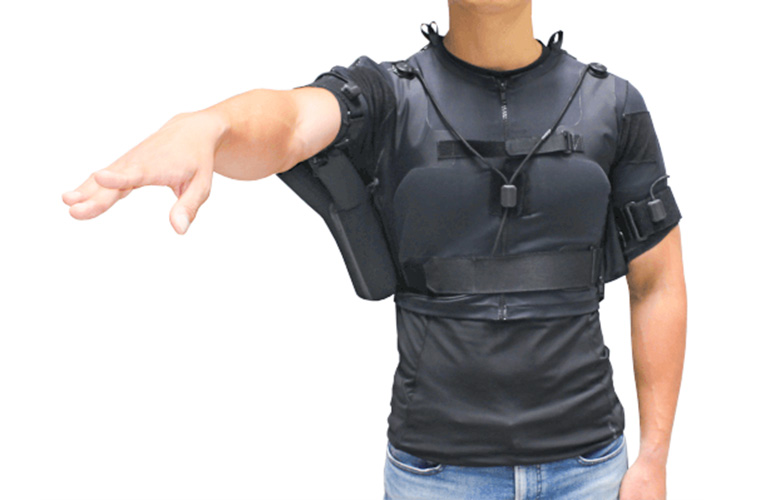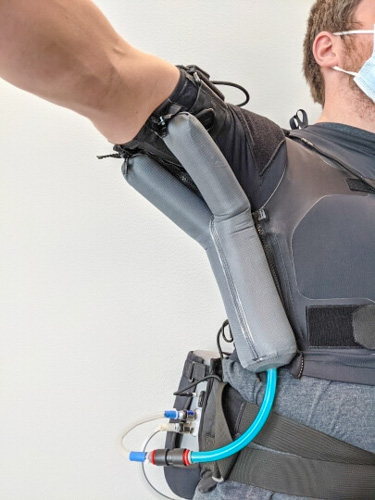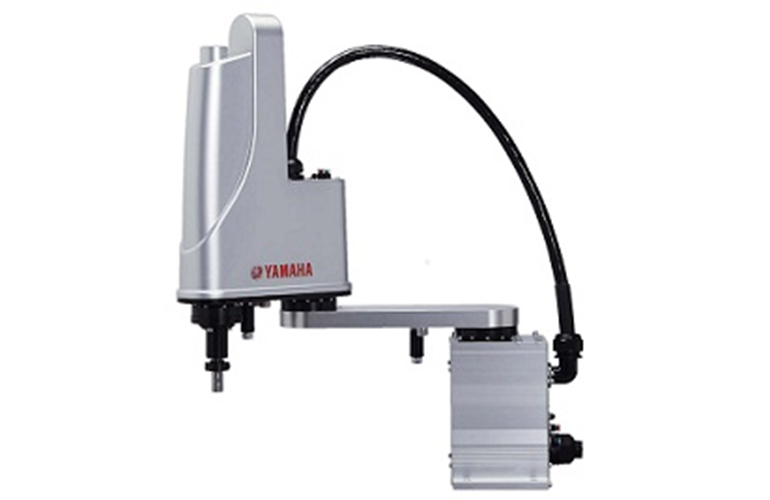Engineers devise a modular system to produce efficient, scalable aquabots
A model that could improve robots’ ability to grasp objects
Soft robotic wearable restores arm function for people with ALS

This soft robotic wearable is capable of significantly assisting upper arm and shoulder movement in people with ALS. | Credit: Walsh Lab, Harvard SEAS
Some 30,000 people in the U.S. are affected by amyotrophic lateral sclerosis (ALS), also known as Lou Gehrig’s disease, a neurodegenerative condition that damages cells in the brain and spinal cord necessary for movement.
Now, a team of researchers from the Harvard John A. Paulson School of Engineering and Applied Sciences (SEAS) and Massachusetts General Hospital (MGH) has developed a soft robotic wearable capable of significantly assisting upper arm and shoulder movement in people with ALS.
“This study gives us hope that soft robotic wearable technology might help us develop new devices capable of restoring functional limb abilities in people with ALS and other diseases that rob patients of their mobility,” says Conor Walsh, senior author on Science Translational Medicine paper reporting the team’s work.
Walsh is the Paul A. Maeder Professor of Engineering and Applied Sciences at SEAS where he leads the Harvard Biodesign Lab, and he has presented related topics at earlier Healthcare Robotics Engineering Forum events.
The assistive prototype is soft, fabric-based, and powered cordlessly by a battery.
“This technology is quite simple in its essence,” says Tommaso Proietti, the paper’s first author and a former postdoctoral research fellow in Walsh’s lab, where the wearable was designed and built. “It’s basically a shirt with some inflatable, balloon-like actuators under the armpit. The pressurized balloon helps the wearer combat gravity to move their upper arm and shoulder.”
To assist patients with ALS, the team developed a sensor system that detects residual movement of the arm and calibrates the appropriate pressurization of the balloon actuator to move the person’s arm smoothly and naturally. The researchers recruited ten people living with ALS to evaluate how well the device might extend or restore their movement and quality of life.
The team found that the soft robotic wearable – after a 30-second calibration process to detect each wearer’s unique level of mobility and strength – improved study participants’ range of motion, reduced muscle fatigue, and increased performance of tasks like holding or reaching for objects. It took participants less than 15 minutes to learn how to use the device.
“These systems are also very safe, intrinsically, because they’re made of fabric and inflatable balloons,” Proietti says. “As opposed to traditional rigid robots, when a soft robot fails it means the balloons simply don’t inflate anymore. But the wearer is at no risk of injury from the robot.”
Robotics Summit (May 10-11) returns to Boston
Register Today
Walsh says the soft wearable is light on the body, feeling just like clothing to the wearer. “Our vision is that these robots should function like apparel and be comfortable to wear for long periods of time,” he says.
His team is collaborating with neurologist David Lin, director of MGH’s Neurorecovery Clinic, on rehabilitative applications for patients who have suffered a stroke. The team also sees wider applications of the technology including for those with spinal cord injuries or muscular dystrophy.
“As we work to develop new disease-modifying treatments that will prolong life expectancy, it is imperative to also develop tools that can improve patients’ independence with everyday activities,” says Sabrina Paganoni, one of the paper’s co-authors, who is a physician-scientist at MGH’s Healey & AMG Center for ALS and associate professor at Spaulding Rehabilitation Hospital/Harvard Medical School.
The current prototype developed for ALS was only capable of functioning on study participants who still had some residual movements in their shoulder area. ALS, however, typically progresses rapidly within two to five years, rendering patients unable to move – and eventually unable to speak or swallow. In partnership with MGH neurologist Leigh Hochberg, principal investigator of the BrainGate Neural Interface System, the team is exploring potential versions of assistive wearables whose movements could be controlled by signals in the brain. Such a device, they hope, might someday aid movement in patients who no longer have any residual muscle activity.

Balloon actuators attached to the wearable move the person’s arm smoothly and naturally. | Credit: Walsh Lab, Harvard SEAS
Feedback from the ALS study participants was inspiring, moving, and motivating, Proietti says.
“Looking into people’s eyes as they performed tasks and experienced movement using the wearable, hearing their feedback that they were overjoyed to suddenly be moving their arm in ways they hadn’t been able to in years, it was a very bittersweet feeling.”
The team is eager for this technology to start improving people’s lives, but they caution that they are still in the research phase, several years away from introducing a commercial product.
“Soft robotic wearables are an important advancement on the path to truly restored function for people with ALS. We are grateful to all people living with ALS who participated in this study: it’s only through their generous efforts that we can make progress and develop new technologies,” Paganoni says.
Harvard’s Office of Technology Development has protected the intellectual property arising from this study and is exploring commercialization opportunities.
The work was enabled by the Cullen Education and Research Fund (CERF) Medical Engineering Prize for ALS Research, awarded to team members in 2022.
Additional authors include Ciaran O’Neill, Lucas Gerez, Tazzy Cole, Sarah Mendelowitz, Kristin Nuckols, and Cameron Hohimer.
Editor’s Note: This article was republished from Harvard University.
The post Soft robotic wearable restores arm function for people with ALS appeared first on The Robot Report.
Towards an interactive cyber-physical human platform to generate contact-rich whole-body motions
ABB uses robots to automate COVID antibody testing
ABB Robotics and the University of Texas Medical Branch’s (UTMB) Life Sciences and Healthcare Lab have developed an automated neutralizing antibody testing system. The robotic system can determine an individual’s immunity to various strains of COVID, and perform other virus testing.
The system is able to increase the number of neutralizing antibody tests performed from 15 a day to over 1,000 daily.
“The ability to carry out more daily tests is the key to generating more data on individual immunity profiles that will help control the further spread of the virus,” Dr. Michael Laposata, professor and chairman of the department of Pathology at UTMB, said. “By transforming the rate at which testing can be carried out and eliminating the need for large numbers of laboratory staff being exposed to the potential risk of infection in manual testing, the automated system we’ve developed with ABB provides an accurate, fast, flexible and safe way of meeting our goals.”
Increasing the number of daily tests can help UTMB researchers better understand how effective COVID vaccines have been. COVID’s many combined mutations have made it challenging for researchers to determine the most effective protection for each variant.
The system aims to detect a SARS-CoV-2 neutralizing antibody without cross-reaction with other infections. The resulting data can be used by the person being tested researchers, and local policymakers to help them make more informed decisions about how to minimize the risk of further spreading the virus.
[See image gallery at www.therobotreport.com]“This project is a clear example of how robotics can increase speed and efficiency, while making work safer for the researchers involved,” Daniel Navarro, Managing Director of Consumer Segments and Service Robotics at ABB, said. “Working closely with UTMB, we are combining our expertise [in] biology, lab process, automation and software to develop and deploy an automated robotic solution that significantly advances and informs our response to the COVID pandemic.”
ABB used its RobotStudio offline programming software to model, iterate and test different combinations of lab equipment and robot positions to develop the system. The entire process, from inception to operation, took just 18 months.
“What we managed to achieve in this project within such a short space of time is extraordinary—many multimillion-dollar companies take several years to create solutions like the one we’ve developed in a fraction of the time,” Juan Garcia, director of Laboratory Services at UTMB, said.
Robotics Summit & Expo (May 10-11) returns to Boston
The post ABB uses robots to automate COVID antibody testing appeared first on The Robot Report.
AI-Powered FRIDA robot collaborates with humans to create art
Yamaha Motor announces robotics business in Singapore

Yamaha’s Global Platform SCARA robot. | Source: Yamaha
Yamaha Motor Co., Ltd. announced that it has established a new company in Singapore aimed at expanding its business in Southeast Asia and India, where demand for robots is growing.
By conducting manufacturer-driven cross-selling in the surface-mounted and industrial robot fields, Yamaha Motor intends to secure new clients in Southeast Asia and India, as well as provide high-quality after-sales services in line with international standards. The company will also strengthen its distributor support system while working to expand its distributor network.
The new company will be named Yamaha Robotics Solutions Asia Pte. Ltd. and registration was completed on January 13, 2023. Going forward, the company will prepare the new company’s office, equipment, and more toward a scheduled start of operations in July this year. Yamaha Motor aims to acquire major global accounts as well as clients that are shifting their production bases to Southeast Asia and India by establishing this company in Singapore, where clients, distributors, and the reach of our competitors’ headquarters intersect.
Robotics Summit (May 10-11) returns to Boston
Register Today
The robotics business is designated as a Strategic Business Field in the Company’s Medium-Term Management Plan. Based on the business’ Yamaha One-Stop Smart Solution concept, the Company will build frameworks enabling the prompt provision of sophisticated, all-inclusive solutions as it aims for further business expansion.
The new business will focus on sales and after-sales services of surface mounters and industrial robots in Southeast Asia and India.
The post Yamaha Motor announces robotics business in Singapore appeared first on The Robot Report.